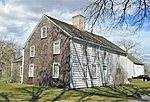Little Compton Common Historic District
Cemeteries in Rhode IslandChurches on the National Register of Historic Places in Rhode IslandCommons category link is locally definedHistoric districts in Newport County, Rhode IslandHistoric districts on the National Register of Historic Places in Rhode Island ... and 4 more
Little Compton, Rhode IslandNRHP infobox with nocatNational Register of Historic Places in Newport County, Rhode IslandUse mdy dates from August 2023

The Little Compton Commons Historic District, or Little Compton Commons, is a historic district in Little Compton, Rhode Island. It is a triangular area roughly bounded by School House Lane to the north, South Commons Road to the east, and Meeting House Lane to the south. Properties continue to the west on West Road.
Excerpt from the Wikipedia article Little Compton Common Historic District (License: CC BY-SA 3.0, Authors, Images).Little Compton Common Historic District
Commons Street,
Geographical coordinates (GPS) Address Nearby Places Show on map
Geographical coordinates (GPS)
| Latitude | Longitude |
|---|---|
| N 41.50949 ° | E -71.17194 ° |
Address
Little Compton Historic District
Commons Street
02837
Rhode Island, United States
Open on Google Maps









